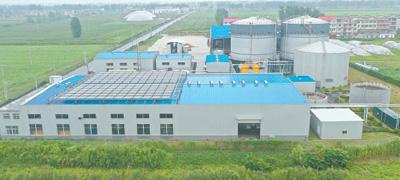
A view of the biogas station in Miaoji Township, Funan County, Fuyang City, Anhui Province (Photo courtesy of Publicity Department of Funan County Party Committee)
Located on the southern part of the Huang-Huai-Hai Plain – a swath of land that extends through Beijing and Tianjin municipalities and Jiangsu, Anhui, Shandong, Henan and Hebei provinces – Funan in Fuyang City, Anhui Province, is one of China's most important grain-producing county-level administrative areas. Producing around 900,000 tonnes of the crop annually, it experienced the burden of having to deal with around 1.2 million tonnes of straw every year prior to the implementation of its comprehensive utilisation campaign.
Funan's farmers usually simply burned the straw stubble that remained in their fields after the summer wheat harvest in preparation for summer sowing shortly after rather than engaging in the laborious, inefficient, and time-consuming process of baling and removing it until just a few years ago. The practice polluted the air, affected traffic safety, increased soil compaction, decreased soil fertility, led to destruction of the soil's microbial layer due to the sharp rise in surface temperatures, and caused disputes when wind resulted in unharvested wheat on neighbouring farms getting scorched as flames spread. Town and village officials' persuasion and supervision efforts eventually led to some farmers disposing of their straw in rivers and ditches after discontinuing the practice, which caused the waters to darken and emit foul odours when the straw decayed.
In 2015, Funan imposed a strict straw burning ban and began exploring ways to make the best use of the by-product, which led to the central government designating it a comprehensive straw utilisation pilot county in July 2017.
Mostly local to the areas they work in and playing an important role in connecting farmers with organisations that utilise straw, traders use machinery to collect and transport the by-product out of fields in a timely manner, store it in a secure and appropriate manner, and provide it to organisations that require it.
Funan's finance department awards traders and enterprises that collect, store, and transport at least 2,000 tonnes of straw per year RMB15 per tonne based on official invoicing after transactions are verified by relevant township governments. More than 170 straw traders are engaged in the business in the county as of summer 2022.
Funan also begun building a straw collection, storage, and transportation system spanning the county, township, and village levels in August 2018 and grants other awards that encourage people, enterprises, and other organisations to engage in the undertaking.
From 2020 to 2021, the county granted more than RMB25 million of awards and facility and equipment subsidies to collection and storage centres and enterprises that utilise straw in a standardised manner, according to the Funan County Bureau of Agriculture and Rural Affairs. A straw collection system involving 27 standardised purchase and storage centres, 84 purchase and storage stations, and 320 purchase and storage sites that have been established at the county, township, and village levels, respectively by 44 agricultural machinery cooperatives and eight enterprises, and 20,000 pieces of straw bundling and transportation machinery has taken shape in the administrative area.
Funan has also vigorously supported projects involving the transformation of straw into biogas, electricity, fertiliser, feed, mushroom substrate, oriented structural straw board, handicrafts, and other products in accordance with local conditions. The county has signed purchase, storage, and utilisation agreements with 135 enterprises that utilise a total of more than 600,000 tonnes of straw per year, distributed RMB160 million of awards and subsidies to the enterprises engaged in comprehensive straw utilisation, and obtained over RMB60 million in funding from the central government for comprehensive straw utilisation pilot projects.
In 2021, more than 1.28 million tonnes of straw were collected in the county, 98.5% of them was comprehensively utilised, and nearly RMB5.5 billion of output value was created by doing so.
The Anhui Provincial Meteorological Science Research Institute has been continuously surveilling the farmland in its borders with remote sensing satellite equipment in recent years. Funan has incorporated the technology into its management strategy, which has made it possible for it to detect, control, and dispose of stubble fires in a more efficient manner than it did in the past when the inspections that officials engaged in were limited by visual fields and coverage areas. The approach has been an important part of ending straw burning in the county. The 81 straw fires that were recorded in 2014 dropped to just 5 in 2019, and there had not been any since 2020 till July 2022.
Reasonable subsidies and awards encourage traders and enterprises to participate in comprehensive straw utilisation, and farmers gain the ability to turn a burden into an asset that becomes an additional income stream when it is sold. The following factors need to be taken into account in order to ensure that this type of undertaking is a success:
Firstly, elements such as nitrogen, phosphorus and potassium are lost when straw is removed from farmland, which can lead to a decline in soil fertility if the undertaking is not managed properly. It is, therefore, important to balance short-term business considerations with long-term sustainability. Organic fertiliser should be applied to the land that the straw comes from rather than large amounts of chemical fertiliser in order to help facilitate sustainable development. Strategies such as crop rotation, manure usage, and cultivation of winter cover crops are also useful ways to address the problem of nutrient loss.
Secondly, diversified utilisation methods that factor in the above as well as factors such as yields and quality should be developed and implemented in order to generate maximum economic value.
Thirdly, large-scale operations make it possible to break the shackles associated with small operations.
For more information, please contact WFP China COE (wfpcn.coe@wfp.org)
Related Links:
http://www.wfpchinacoe.net/2022-08/29/content_78394588.shtml
2. Reducing Expenses and Boosting Incomes with Biogas in Funan County
http://www.wfpchinacoe.net/2022-08/29/content_78394739.shtml
Source:https://baijiahao.baidu.com/s?id=1738376783931871140&wfr=spider&for=pc
Category
Funan County Unlocks the Power of Straw
Contributor
Funan County Unlocks the Power of Straw
Country
Case Study

